March - April 2008

To begin with, we would like to thank the following for assisting with the banding at Powdermill in March and April: Mary Shidel, Kristin Sesser, Julie Means, Pam Ferkett, Lauren Schneider, Dean Thompson, Matthew Shumar, Danilo Mejía, Marisabel Paulino, Gerardo Rodríguez Ramos, and Rob Slebodnik. The last four comprise the 2008 field crew for our long-term (since 1996) banding study of Louisiana Waterthrushes at Powdermill, currently a collaboration between Powdermill Avian Research Center (Robert Mulvihill) and The National Aviary (Dr. Steven Latta).
For Danilo and Marisabel, it is their second season helping at Powdermill after spending the past fall and winter conducting preliminary studies of LOWA in their home country of the Dominican Republic. Gerardo came to Powdermill this year by way of the University of Guadelajara (CUCSUR, in Autlán in the state of Jalisco in west-central Mexico) where he received his degree in Natural Resources. Rob is from Ligonier, a small town near Powdermill—he has a Wildlife Biology degree from California University of Pennsylvania.
We also received help from these colleagues and visitors: Greg George, Jean Rothe Deo, Ben Coulter, Emma DeLeon, Patrick McElhone, Amy Bowman, M. Kathleen Klimkiewicz, C. J. Ralph, Leo Salas, Mark Newstrom, Richard Joos, and Powdermill's very own Adrienne Leppold (on spring break from her graduate studies at the University of Maine).
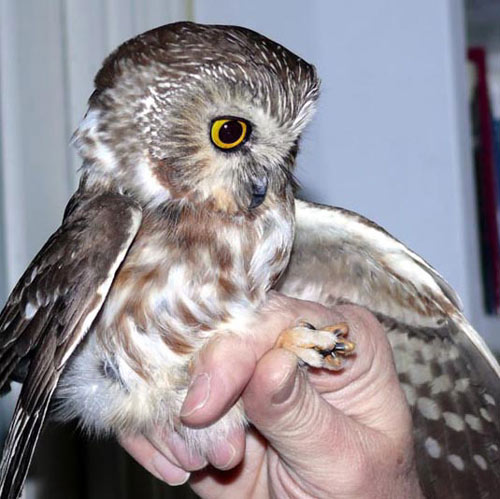
We banded on twelve days in March, in the process capturing 209 new birds of 19 species and recapturing 132 birds. Three species accounted for nearly 80% of all birds banded: Dark-eyed Juncos (88 banded), Song Sparrows (47), and Fox Sparrows (30). We netted two female Northern Saw-whet Owls on the night of 3/26, one of which is pictured to the left.


Despite opening nets on 24 days in April, the resulting total of 654 banded birds was lower than 2007, when a below-average total of 728 was thought to be due primarily to heavy freezes the first half of the month. In comparison, temperatures were moderate this April.
Capture rates were much lower at the end of the month compared to the first half, but there was a small "push" of Neotropical migrants in the last week of April. The busiest banding day of the month occurred on 4/12--the majority of the 58 birds banded that day were wintering bird species trapped near our bird feeders.
Sixty-five species were banded in April--the top five were Dark-eyed Junco (107 banded), Ruby-crowned Kinglet (102), American Goldfinch (68), Song Sparrow (50), and Chipping Sparrow (46).
What the month lacked in quantity of birds banded was compensated by quality. A handful of frequently missed or very rare species were captured. Among these unusual and interesting captures was this female Hooded Merganser (pictured left) netted on 4/22, only the second of its kind ever banded at Powdermill!
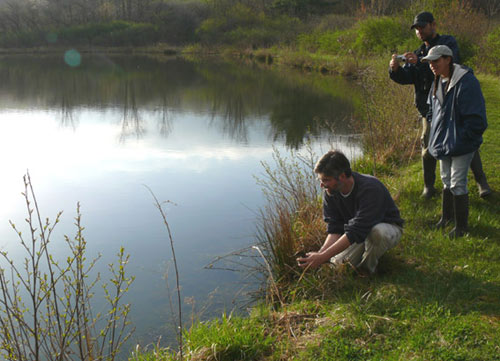
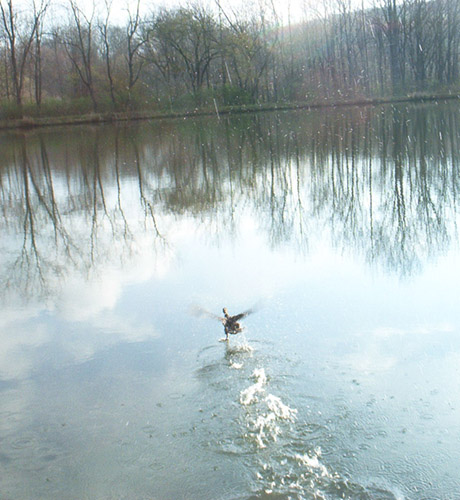
Gerardo Rodriguez Ramos and Marisabel Paulino look on as Bob Mulvihill releases the Hooded Merganser back onto Crisp Pond, where it quickly skitters away (photos by Molly McDermott).
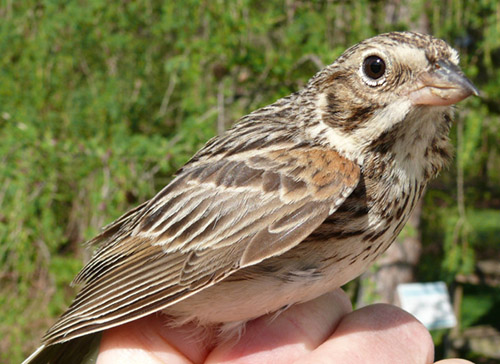

On 4/24 we captured a Vesper Sparrow, a very "good get," considering that we last banded one in 1995!
Vesper Sparrows were once more commonly captured due to more grassland habitat in the vicinity of the net lanes. This individual was aged SY and had an A1 molt limit visible in the spread wing photo to the left.


On 4/30 we banded a Pileated Woodpecker, an infrequently caught species.
This male was aged TY based on the the presence of three different generations (one being juvenal) among the feathers of the wing.
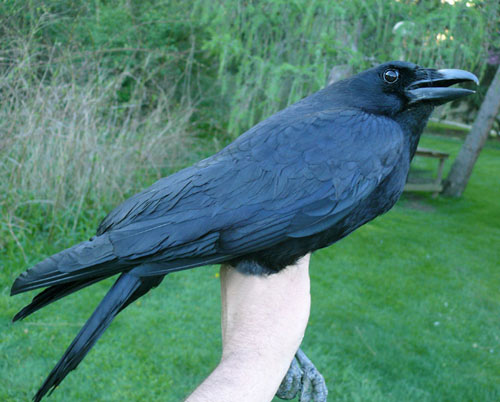

Of note in April were the recaptures of two very old corvids:
This American Crow (Pictured at Top) was banded as an ASY in 1998, making it at least 12 years old...
...and this Blue Jay (Pictured at Bottom) banded as an HY in 1996 was nearly 12 years old.



Also of note were these two partially amelanistic birds:
First, an ASY female Dark-eyed Junco with white cap and scattered white wing feathers...
...and this "white-crowned" White-throated Sparrow. Pictured Below.


April was a good month for Eastern Bluebirds investigating/nesting in nest boxes scattered around ponds in the banding area. Pictured below is an ASY male captured on 4/20.
Unlike the shades of black, brown, red, yellow, and orange that color the plumages of birds with chemical pigments derived from dietary sources, the colors green (usually) and blue in bird feathers are a consequence of feather microstructure (i.e., reflecting light within the blue wave lengths of the visible spectrum).
Thus, the colors blue and green can appear to disappear, depending on the angle of light in relation to the angle at which these feathers are viewed. In taking a series of photos intended to depict the evenly aligned growth bars in the wing of this SY female bluebird, we inadvertently demonstrated the structural nature of blue coloration in bird feathers.
A small change in the angle of the wing relative to the camera lens changed the appearance of the wing feathers from decidedly brownish to bright blue.

Red-winged Blackbird males, like these two banded on April 20, are very easily aged by plumage. The ASY male on the left has bright scarlet red epaulets and velvety black body plumage compared to the much duller SY male on the right.

The majority of Dark-eyed Juncos banded at Powdermill belong to the nominate eastern race, Junco hyemalis hyemalis (First Bird to the left), one of 12 Junco subspecies described in Pyle (1997).
Another race occasionally captured at Powdermill is the locally breeding southern Appalachian race, Junco hyemalis carolinensis (Second Bird on right). Among other things, carolinensis is distinguished by a bluish, rather than pinkish bill (a sometimes subtle difference captured particularly well in the photo below).

As mentioned above, a few Neotropical migrants began to trickle in before the end of April.
First White-eyed Vireo was banded on 4/20.

First wood warblers captured (aside from Louisiana Waterthrushes banded as part of the long-term study at Powdermill) were an Orange-crowned Warbler on 4/19, and a hybrid "Brewster's" and Blue-winged Warbler (below) on 4/26

An Ovenbird was banded on 4/27.


We thought that this SY male Black-throated Green Warbler (Pictured Top), also banded on 4/27, had an unusually well-defined black facial pattern.
Our first Kentucky Warbler was banded on 4/30 (Pictured Below).


Two SY male Indigo Buntings banded on 4/29 showed a very marked contrast in the extent of their prebasic and prealternate molts.

Before the end of April, we caught females of some early nesting species that were in a gravid (egg-laying) condition, such as this Red-breasted Nuthatch... (Pictured to Left)
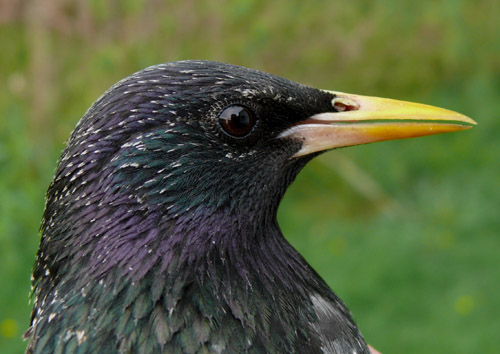

...and this female European Starling (Pictured Top).
The starling pictured below is a male banded last spring. Compared to the female above, the photo below illustrates two key differences between the sexes: females (appropriately enough) have pink at the base of their bill, while males have blue; males have much longer iridescent throat "hackles" than females; last (although difficult to see in these photos), females have narrow light circles around their dark irides, whereas males have uniformly dark eye color.
